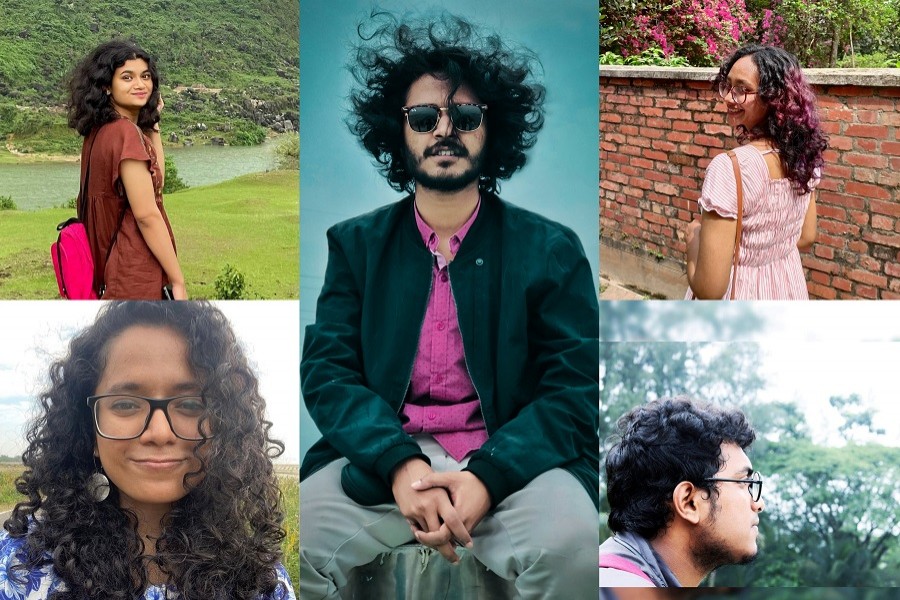Afia Mazhar Kowshi, in her late teens, was having a particularly bad day taming her shoulder-length curls. For a party she was to attend, she felt this enormous pressure on her part to try to straighten it out with an electric straightener.
Kowshi ended up burning her earlobe while straightening. But she did it anyway, burnt some of her hair too in the process.
The Bangladeshi beauty standard somehow bound itself to the silky straight hair that glides on like Rapunzel’s lustrous length and all for some reason. So, there is a fair chance that someone with bouncy curls and twisted tresses was once cornered to the room and never been praised for their hair.
But the actual beauty of the Bengali hair lies in the different kinds of natural hair textures seen around, from straight, wavy, to beautiful big and small naturally forming ringlets. Especially focusing with the ones struggling down the road to loving their curly tresses and natural locks.
So, what is it like to have curls in a country where straight hair is always lauded? How is the journey of people with twisted locked tresses?
Sumaya Tasmim Kheya studies Law and Justice at Jahangirnagar University. She shares her thoughts of being someone with naturally curly hair from her childhood.
“Growing up, I was always made to feel like an anomaly for having curly hair. The peer pressure to straighten my hair was insane. Some people acted like it’s a disability of some sort, ranging from pity to ridicule.”
But Merin Mostaba Mati has somewhat different point of view on this. Mati says, “Having curls made me feel different from others and sometimes, I would just feel lucky to be counted as ‘special.’ I have always liked natural curls.”
Mati is presently studying Mass Communication and Journalism at the University of Dhaka.
Abu Sufian Arnab didn’t specify the people who’d stereotyped his locks to one group only. Apart from his parents, it was almost everyone.
“They’d call my hair a bowl of Maggi Noodles, or compare it to Malinga’s (Sri Lankan fast bowler) tresses. My peers at the school and sometimes the teachers would make fun of my natural hair.”
“It was hard to cope with that situation because it would make me feel like there was something off about me,” regretted Arnab, who is also a student of Mass Communication and Journalism at the University of Dhaka.
How was it like having curls at a younger age? Kheya answers, “I felt a bit ostracized when I was a little girl. I was made to feel like I’d be pretty if only I didn’t have the ‘misfortune’ to have curls.”
“While growing up, some of my curly haired friends were getting their hair permanently straightened, and their ‘glow up’ was so praised that I felt like, well, that must be the key to unlocking prettiness.”
Zakia Sameen Noor, a student of Economics at the University of Dhaka, shares her views.
“My negative memories would be my constant desperation for wanting straight hair, or whining over it when I couldn’t straighten it out to look ‘pretty.’ I also felt embarrassed with my frequent boycuts and never letting my hair grow.”
As someone who was into stars on screen, Zakia battled to keep her mind off as it would be a constant reminder by her peers that she was nothing like them.
Accepting is always a learnt behaviour and accepting one’s own identity and appearance is nothing short of an act of bravery.
“After I learned to manage my curls better, I got compliments from the girls at my university almost every day. They’d ask me about my hair routine and I love that.”
“And what I love the most is when kids stare at my hair, with genuine fascination. It makes me feel like they’re not chained by the norms of growing up with the messed-up beauty standards I grew up with,” Kheya adds.
“Growing up, it was a tough task to have been criticised for the texture or length of my hair so many times, for me and sometimes for my family as well. But after I stepped into university, my friends, teachers praised my hair. I also got a lead role in a play because my appearance and acting were just the right fit,” Merin says.
The Curly Girl Method or CGM has gained popularity in Bangladesh lately. A lot of Curlies are now interested in preserving the naturality of their hair textures and taking care of it.
The CGM requires maintaining a routine that is specially made for nourishing and defining curls better.
Zakia uses the CGM methods to take care of her curls. She says, “As good as it feels, I remind myself not to obsess like in my early years of CGM but rather take it slow and just enjoy the process. It’s self-care for me.”
The traditional point of view of perceiving curly hair as something ‘ugly’ or ‘flawsome’ is nothing more than a wretched negativity without any basis.
Every hair type is beautiful, as everybody is beautiful. It is high time the torchbearers of the darkened world of ‘beauty standards’ started unlearning naturally curly hair negativity.


